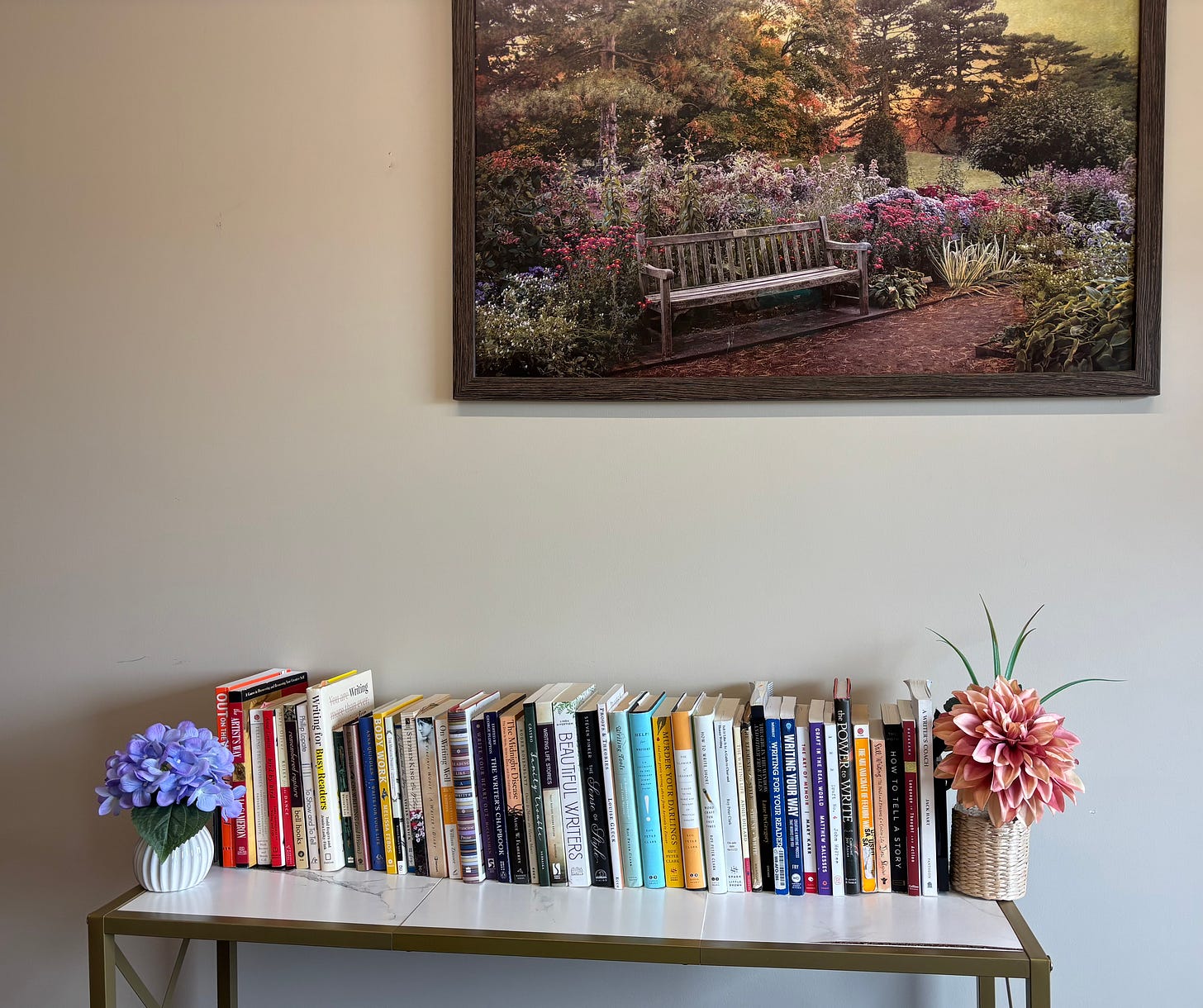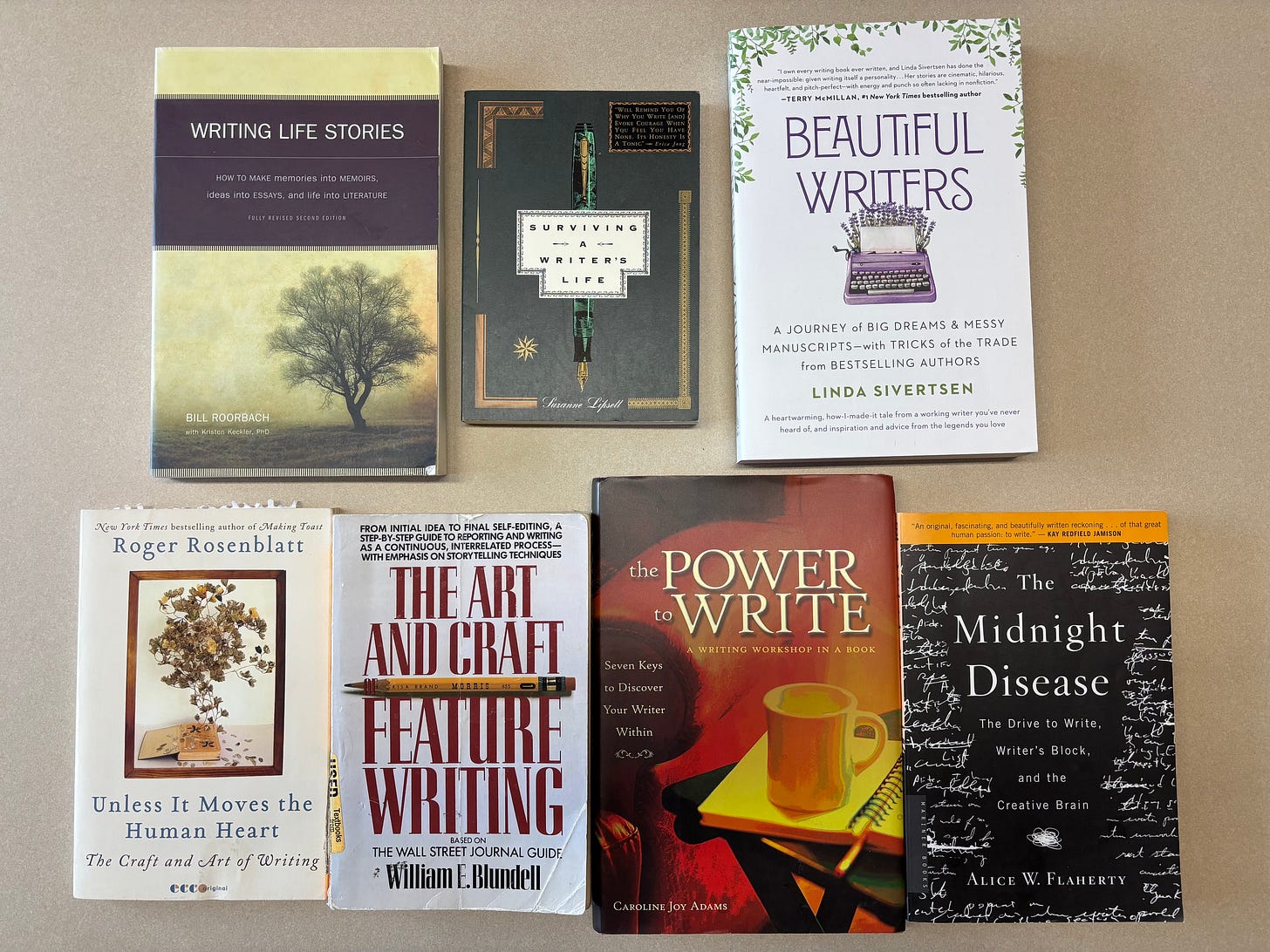I’m the type of writer who loves talking and reading about the craft of writing. I have a whole collection of craft books, and I know which ones to turn to when I’m in a writing rut or when I’m navigating a related challenge (usually pertaining to focus or structure). I like sharing them with my students, too.
Over the past few weeks, I’ve been compiling a guide to books on storytelling for Harvard University’s Nieman Storyboard. The guide, which was published this morning, covers a variety of genres, including journalistic writing, narrative nonfiction, oral storytelling, screenwriting, and fiction.
When creating the guide, I drew upon my own collection of books, which includes treasures from bell hooks, Stephen King, Dani Shapiro, S.I. Hawakaya, Matthew Salesses, and more. I also asked for input from Nieman Storyboard readers, who were generous in sharing recommendations.
There simply wasn’t enough room to include all of my favorite writing books, so I’m sharing a few more here. I’d love to hear your own recommendations, and I hope you’ll check out the Nieman Storyboard guide.
Memoir & personal essay writing:
“Family Trouble” by Joy Castro (I turned to this book a lot when writing my forthcoming memoir, SLIP. It’s my go-to guide for navigating the highs and lows of reporting on/writing about family, and I recommend it to anyone who has questions about how to do this fairly.)
“The Art of Memoir” by Mary Karr (I read this book before writing my memoir, and it gave me some much-needed inspiration. I found Karr’s section on the malleability of memory to be both compelling and instructive.)
“Body Work” by Melissa Febos (This is a thought-provoking book that gave me a lot to think about. I’ve always appreciated this particular passage: “Navel-gazing is not for the faint of heart. The risk of honest self-appraisal requires bravery. To place our flawed selves in the context of this magnificent, broken world is the opposite of narcissism, which is building a self-image that pleases you.”)
“The Memoir Project” by Marion Roach Smith (This small book is easy to read, and it’s especially helpful for writers who are just beginning to pursue personal essay or memoir writing.)
General writing:
“On Writing Well” by William Zinsser (I got to interview Zinsser a few years before he died, and I wrote a related Poynter.org piece showcasing five of his top writing tips. Among my favorite takeaways from our conversation: “All writing to me is a journey. It’s saying to the reader, ‘Come along with me; I’ll take you on a voyage.’” I like thinking of writing as a process of discovery.)
“On Writing (and Writers)” by C.S. Lewis (I’m a longtime fan of Lewis’ work but didn’t stumble upon this book until just last year. He tackles a range of genres in the book, with tips on writing science fiction, writing persuasively, and writing for children.)
“How to Write Short” by Roy Peter Clark (As a writer who has to watch for wordiness, I’ve long turned to this book as a reminder of how to make every word count. As I often tell my students: “Concision takes precision,” and “it’s often harder to write short than it is to write long.” This book is a great tool for teaching this advice.)
“Writing Down the Bones” by Natalie Goldberg (My former boss gave me this book, and I keep it displayed on my bookshelf at home. I’ve always appreciated this particular passage: “If you are not afraid of the voices inside you, you will not fear the critics outside you.” I’m keeping this in mind as my memoir begins to make its appearance in the world.)
“To Show and to Tell” by Phillip Lopate (The old adage “show, don’t tell” can be misleading. The reality is, we need to both show and tell in our writing. Where many fall short is in the showing. I like to think of it this way: Telling gives readers insight. Showing gives them eyesight — to see what you’re describing. This book helps writers capture the beauty of both.)
Revision:
“The Art of Revision” by Peter Ho Davies (There are a lot of books on writing, but far fewer on revision. I’m drawn to books like Davies’, which pulls back the curtain on what he calls the “invisible” process of editing. By making the process visible, he shows its value and significance.)
“Murder Your Darlings” by Roy Peter Clark (This book is a nod to the famous quote from the late British novelist Sir Arthur Quiller-Couch, who said writers need to be willing to remove passages that don’t serve a story well. Over the years, I’ve gotten better at parting with my darlings instead of holding onto them with a white-knuckled refusal to let go.)
“Revisionaries” by Kristopher Jansma (Open this newly released book and you’ll be taken back in time to abandoned drafts and discarded projects from 20 influential writers, including Louisa May Alcott and Octavia Butler. The book is a refreshing reminder that even the greatest writers struggle with their prose at one point or another. Speaking truth to this reality is important, especially for those of us who are hard on ourselves when our writing doesn’t match our expectations.)
Writing for business:
“Writing for Busy Readers” by Todd Rogers and Jessica Lasky-Fink (I use this book in my UT Austin “Writing for Accountants” course, which is aimed at helping aspiring accountants to become better writers. The book is filled with practical checklists and real-world examples, and I’ve found it especially beneficial for people who want to be better at writing but don’t necessarily consider themselves to be writers.)
“The Sense of Style” by Steven Pinker (I teach this book to my accounting students as well and appreciate the ways that Pinker draws upon linguistic research to inform his arguments. The book includes helpful advice on how to avoid common problems in writing, including nominalization and overuse of the passive voice.)
Developing a writer’s lifestyle/routine:
“The Writing Life” by Annie Dillard (This Write at the Edge newsletter is partly inspired by a question that Dillard raises her book: “Where is an edge — a dangerous edge — and where is the trail to the edge and the strength to climb it?” It’s a question that has motivated me to take risks with my writing and pushed me into new territory.)
“The Artists’ Way” by Julia Cameron (Many writers I know swear by this book. I’ve found it helpful to turn to from time to time, and I’ve written down many quotes from it over the years. Among my favorite: “We always do the best we can by the light we have to see by.” So much of writing is about finding the light in oneself and then using it to explore the darkness.)
“Write for Your Life” by Anna Quindlen (I got to meet Anna several years ago and have always been drawn to her writing. “Write for Your Life” is a beautiful companion for any writer. I’ve carried it close for many years, and I’ve sought comfort in its lyrical advice.)
New ones to look forward to:
“Dear Writer” by Maggie Smith (This book just came out, and it’s at the top of my to-read list. I especially like that it includes handwritten passages from Smith’s own writing and that it’s filled with related exercises that are great for individual writers and classrooms.)
“How to be Heard” by Roxane Gay (This forthcoming craft book is sure to be an insightful read about finding and amplifying one’s writing voice. I’ve learned so much from Gay’s writing over the years and have been hoping she would come out with a craft book. Alas, it won’t be released until April 2026, but I’m sure it will be worth the wait.)
You can check out more craft books in my Nieman Storyboard guide. I’d love to hear your own recommendations too! Please share them in the comments section.






Two books about writing that I come back to over and over are The Writer's Portable Mentor by Priscilla Long and John McPhee's Draft No. 4. Also Verlyn Klinkenborg's Several Short Sentences About Writing is not exactly a craft book, but it's so beautifully written that I think it made me a better writer just spending time in its pages.
I just forgot to say I really want to read the books you advise !